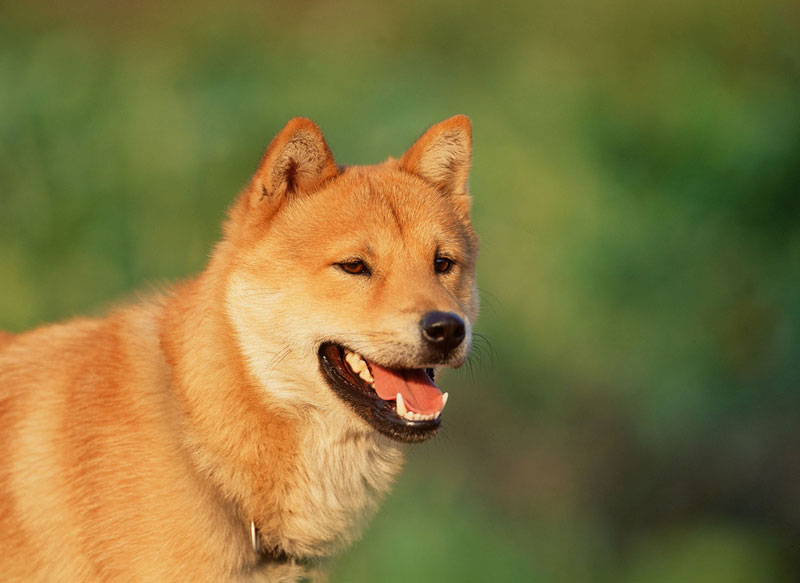The Korean Jindo Dog is a breed of hunting dog known to have originated on Jindo Island in South Korea. Brought to the United States with South Korean expatriates, it is celebrated in its native land for its fierce loyalty and brave nature. The Jindo breed became recognized by the United Kennel Club on January 1, 1998 and by the Fédération Cynologique Internationale in 2005.
History
There is no written record of the origin of the Korean Jindo Dog. Authorities agree that the Jindos originated and existed on Jindo Island for a long time. There have been many theories regarding the origin of Jindo Dog. One of the theories describes Jindo as cross-breeds with Mongolian dogs when Mongol forces invaded Korea around the 13th century.They are now protected under the Cultural Properties Protection Act.In 1962, the Government of South Korea designated the Jindo as the 53rd 'Natural Treasure' (or translated as 'Natural Monument') (천연기념물; 天然記念物) and passed the Jindo Preservation Ordinance. Because of the special status of the Jindo, it is very difficult to export purebred Jindo outside of Korea. Jindos marched in the opening ceremonies of the 1988 Summer Olympic Games in Seoul, Korea. The United Kennel Club recognized the Jindo on January 1, 1998.The Jindo Dogs Guild of Korea(한국 진돗개 조합), as of 2008, issues certificates of pure Korean Jindo Dog, which specifies the registered number of the mother, sex, and birth date of the dog, as well as breeder's address and whether the dog is of purebred.The breed first appeared in the West in France and has since made its way over to the U.S. There are 25 registered Jindos in the United Kingdom. Also, the Korean government and Samsung Group have contributed to efforts to gain international recognition for the Jindo.
Hunting
The Jindo are renowned for their outstanding hunting ability, due to their courage, cunning, and pack sensibility. Besides the usual prey of medium to large game, their hunting prowess is displayed in a legend of three Jindos that killed a Siberian tiger. They have mainly been used as deer and boar hunters. There have been anecdotal reports of Korean owners being awakened by their Jindo one morning to be led deep into the forest to a deer the dog had taken down alone. There have also been reported cases in America of intruding coyotes being killed by Jindos defending their territory. In traditional Korean hunting without guns, a pack of well trained Jindos was extremely valuable. A master with a loyal pack could hunt without much trouble at all, for when the pack brings down a deer, boar or other target, one of them returns to the master to lead him to the prey, while the others stand guard against scavengers.
As Police and Military Dogs
In a 2009 interview with Korea Economic Daily (한국경제), Bak Nam-sun (박남순), an expert search dog handler in South Korea, testified that Jindo dogs are not fit as rescue dogs and search dogs. It is because Jindo dogs' hunting instincts are too strong (they can forget their mission because of their hunting instincts), and they usually give their loyalty only to the first owner, while handlers of search dogs and rescue dogs can frequently change.In 2010, Son Min Suk (손민석), a member of Korean Security Forum, wrote that most of Korean military dogs were German Shepherds, and that Jindo dogs were not fit for military dogs as they were highly likely to escape their duties to find their first handlers who might be discharged from military services or to come back to their original home.However, efforts to train Jindo dogs as search and rescue dogs continue. In October 2010, the Los Angeles Police Department announced their intent to evaluate the Jindo dog breed for law enforcement service, specifically for patrol and detection service. Four selected Jindo puppies would be distributed to LAPD and Glendale, California California Police Department to be trained as K9 units. After a year of trying, the trainers found that the dogs did not have the right disposition for police work because they were too easily distracted and too eager to please their masters.
Anecdotes on Loyalty of Jindos
In 1993, a 7-year-old female Jindo named Baekgu (백구; 白狗; translated as a White Dog), raised by Bak Bok-dan (박복단), an 83-year-old woman in Jindo Island, was sold to a new owner in the city of Daejeon which is located about 300 km (180 mi) away from the island. The dog escaped her new home and returned to her original owner, Bak, after 7 months, haggard and exhausted. Baekgu remained with her original owner, who decided to keep the loyal dog, until the dog died of natural causes 7 years later. The story was a national sensation in Korea and was made into cartoons, a TV documentary, and a children's storybook. In 2004, Jindo County erected a statue of Baekgu in her hometown to honor the dog.Another Jindo, also named Baekgu, a 4-year-old male at the time who lived alone with his owner Park Wan Suh (박완서) residing in Jindo Island, did not eat anything and mourned for his dead owner for seven days after the owner died from a liver disease in June 2000. According to Chosun Ilbo, the dog accompanied his dead owner for three days until other people came to find the body, followed the owner to his funeral, and came back home, not eating anything for four days. The Korean Jindo Dog Research Institute (진돗개 시험연구소) brought him under its care, but a person related to the Institute announced that the dog would not interact with anyone except for his feeder as of 2005.






